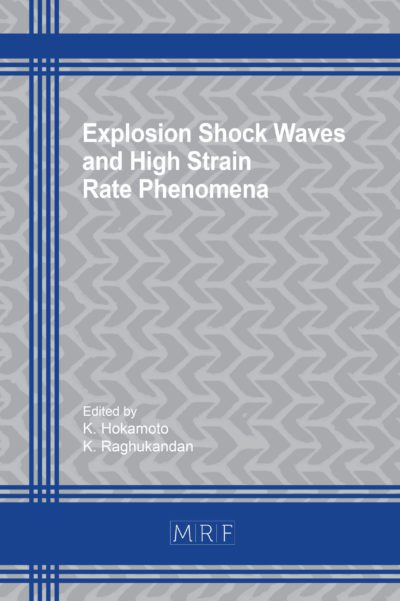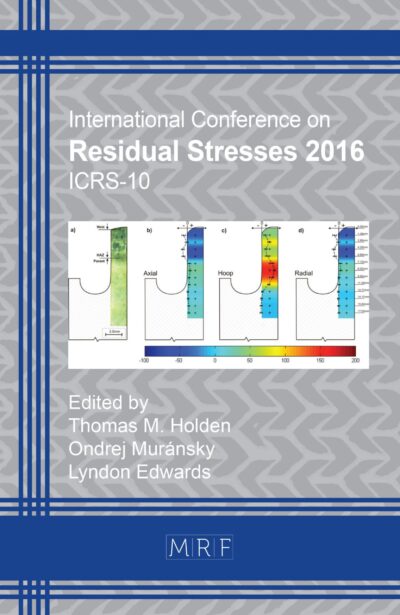Process – structure – property relations in DP800 investigated using representative volume elements
Niklas C. Fehlemann, Dorothea Czempas, Maximillian Hribsek, Sebastian Münstermann
Abstract. Dual-phase (DP) steels play a crucial role for various applications due to their good balance of formability and strength. This paper explores the influence of the pass reduction during cold rolling on the microstructure and mechanical properties of a DP800 steel. A ferritic-pearlitic base material was cold rolled with varying pass reductions, followed by intercritical annealing at a constant temperature. Microstructural characterization was performed using light optical microscopy and electron backscatter diffraction, while tensile tests provided insights in the macroscopic mechanical property. Statistically representative volume elements (sRVE), generated with the in-house DRAGen RVE-generator were employed in conjunction with crystal plasticity simulations to analyze the strain partitioning and the damage behavior. Results show that pass reduction during cold rolling significantly affects microstructure and strain partitioning, influencing damage tolerance and therefore also the formability. Increasing the number of passes leads to more homogenous stress and strain distribution with less damage. These findings highlight the importance of process design in optimizing DP steel damage tolerance.
Keywords
Dual Phase Steel, Representative Volume Elements, Damage, Microstructure, Formability
Published online 5/7/2025, 10 pages
Copyright © 2025 by the author(s)
Published under license by Materials Research Forum LLC., Millersville PA, USA
Citation: Niklas C. Fehlemann, Dorothea Czempas, Maximillian Hribsek, Sebastian Münstermann, Process – structure – property relations in DP800 investigated using representative volume elements, Materials Research Proceedings, Vol. 54, pp 995-1004, 2025
DOI: https://doi.org/10.21741/9781644903599-107
The article was published as article 107 of the book Material Forming
![]() Content from this work may be used under the terms of the Creative Commons Attribution 3.0 license. Any further distribution of this work must maintain attribution to the author(s) and the title of the work, journal citation and DOI.
Content from this work may be used under the terms of the Creative Commons Attribution 3.0 license. Any further distribution of this work must maintain attribution to the author(s) and the title of the work, journal citation and DOI.
References
[1] A. Tran, J. A. Mitchell, L. P. Swiler, and T. Wildey, An active learning high-throughput microstructure calibration framework for solving inverse structure‐process problems in materials informatics. Acta Materialia (2020) 80-92. https://doi.org/10.1016/j.actamat.2020.04.054
[2] N. Fehlemann, D. Czempas, M. Könemann, D. Lenz, G. Hirt, and S. Münstermann (2024, Investigation of Damage-Controlling Process-Parameters During Cold Rolling on the Impact Toughness of DP800 Steel Under Crash Loading Stress States. In Proceedings of the 14th International Conference on the Technology of Plasticity – Current Trends in the Technology of Plasticity, K. Mocellin, P.-O. Bouchard, R. Bigot and T. Balan, Eds. Lecture Notes in Mechanical Engineering. Springer Nature Switzerland, Cham) 232-242. DOI=10.1007/978-3-031-42093-1_23. https://doi.org/10.1007/978-3-031-42093-1_23
[3] A. E. Tekkaya, N. Ben Khalifa, O. Hering, R. Meya, S. Myslicki, and F. Walther, Forming-induced damage and its effects on product properties. CIRP Annals, 1 (2017) 281-284. https://doi.org/10.1016/j.cirp.2017.04.113
[4] S. Bargmann, B. Klusemann, J. Markmann, J. E. Schnabel, K. Schneider, C. Soyarslan, and J. Wilmers, Generation of 3D representative volume elements for heterogeneous materials: A review. Progress in Materials Science (2018) 322-384. https://doi.org/10.1016/j.pmatsci.2018.02.003
[5] G. Bradski, The OpenCV Library. Dr. Dobb’s Journal of Software Tools (2000).
[6] M. Henrich, N. Fehlemann, F. Bexter, M. Neite, L. Kong, F. Shen, M. Könemann, M. Dölz, and S. Münstermann, DRAGen – A deep learning supported RVE generator framework for complex microstructure models. Heliyon, 8 (2023) e19003. https://doi.org/10.1016/j.heliyon.2023.e19003
[7] N. Fehlemann, Y. Sparrer, F. Pütz, M. Konemann, and S. Münstermann, Influence of synthetically generated inclusions on the stress accumulation and concentration in X65 pipeline steel. IOP Conference Series: Materials Science and Engineering, 1 (2021) 12056. https://doi.org/10.1088/1757-899X/1157/1/012056
[8] F. Roters, M. Diehl, P. Shanthraj, P. Eisenlohr, C. Reuber, S. L. Wong, T. Maiti, A. Ebrahimi, T. Hochrainer, H.-O. Fabritius, S. Nikolov, M. Friák, N. Fujita, N. Grilli, K. Janssens, N. Jia, P. Kok, D. Ma, F. Meier, E. Werner, M. Stricker, D. Weygand, and D. Raabe, DAMASK – The Düsseldorf Advanced Material Simulation Kit for modeling multi-physics crystal plasticity, thermal, and damage phenomena from the single crystal up to the component scale. Computational Materials Science (2019) 420-478. https://doi.org/10.1016/j.commatsci.2018.04.030
[9] F. Pütz, N. Fehlemann, V. Göksu, M. Henrich, M. Könemann, and S. Münstermann, A data driven computational microstructure analysis on the influence of martensite banding on damage in DP-steels. Computational Materials Science (2023) 111903. https://doi.org/10.1016/j.commatsci.2022.111903
[10] T. Maiti and P. Eisenlohr, Fourier-based spectral method solution to finite strain crystal plasticity with free surfaces. Scripta Materialia (2018) 37-40. https://doi.org/10.1016/j.scriptamat.2017.09.047
[11] R.-M. Rodriguez and I. Gutiérrez, Unified Formulation to Predict the Tensile Curves of Steels with Different Microstructures. MSF (2003) 4525-4530. https://doi.org/10.4028/www.scientific.net/MSF.426-432.4525
[12] L. Samek, B. C. de Cooman, J. van Slycken, P. Verleysen, and J. Degrieck, Physical Metallurgy of Multi‐Phase Steel for Improved Passenger Car Crash‐Worthiness. steel research int., 11 (2004) 716-723. https://doi.org/10.1002/srin.200405833
[13] J. M. Hodge and M. A. Orehoski, Relationship between hardenability and percentage of martensite in some low-alloy steels. Transactions of the American Institute of Mining and Metallurgical Engineers, 167 (1946) 627-642.
[14] C. Kusche, T. Reclik, M. Freund, T. Al-Samman, U. Kerzel, and S. Korte-Kerzel, Large-area, high-resolution characterisation and classification of damage mechanisms in dual-phase steel using deep learning. PloS one, 5 (2019) e0216493. https://doi.org/10.1371/journal.pone.0216493
[15] C. C. Tasan, M. Diehl, D. Yan, M. Bechtold, F. Roters, L. Schemmann, C. Zheng, N. Peranio, D. Ponge, M. Koyama, K. Tsuzaki, and D. Raabe, An Overview of Dual-Phase Steels: Advances in Microstructure-Oriented Processing and Micromechanically Guided Design. Annu. Rev. Mater. Res., 1 (2015) 391-431. https://doi.org/10.1146/annurev-matsci-070214-021103
[16] D. L. Steinbrunner, D. K. Matlock, and G. Krauss, Void formation during tensile testing of dual phase steels. Metall Trans A, 3 (1988) 579-589. https://doi.org/10.1007/BF02649272
[17] N. Fehlemann, A. L. Suarez Aguilera, S. Sandfeld, F. Bexter, M. Neite, D. Lenz, M. Könemann, and S. Münstermann, Identification of Martensite Bands in Dual‐Phase Steels: A Deep Learning Object Detection Approach Using Faster Region‐Based‐Convolutional Neural Network. steel research int., 7 (2023). https://doi.org/10.1002/srin.202200836














